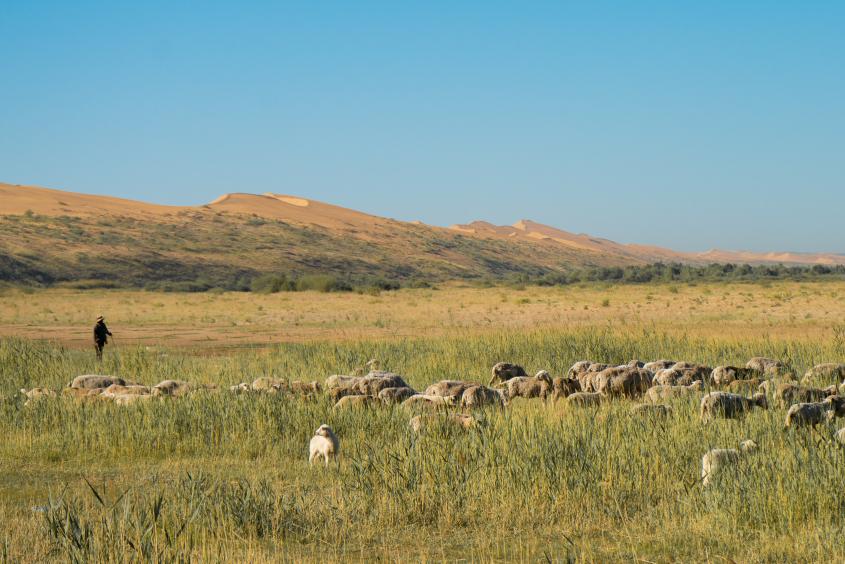Anthrax arms race helped Europeans evolve against deadly disease
New research from the Cornell College of Veterinary Medicine has revealed how humans evolved greater resistance against anthrax multiple times during history: when they developed a diet of more ruminants, and when agricultural practices took hold.
Anthrax grabbed the nation’s attention when it was used in bioterrorism attacks in 2001, but the disease has haunted humans for much longer. Over millennia, humans and anthrax have co-evolved. According to a study in Nature Communications from the lab of Dr. Charles Danko, this resulted in humans, particularly humans of European descent, evolving fewer anthrax receptors that allow the disease to take hold in the body.
“We found evidence of multiple stages of adaptation in humans, which is one of the more important aspects of our discovery,” said Danko, the Robert N. Noyce Associate Professor in Life Science and Technology and researcher with the Baker Institute of Animal Health.
Encountering anthrax
Anthrax bacteria’s main host are ruminants such as cattle and sheep. The grazing animals inhale the bacteria spores and become infected, and soon die from toxins produced from the bacteria. The decaying carcass returns the bacteria to the soil and vegetation, repeating the cycle. How humans became entangled in this host-pathogen affair was not entirely clear, until the Danko team began diving into the genetic patterns.
Dr. Lauren Choate, former Danko lab graduate student and current genomics fellow at the Mayo Clinic, examined genomic sequences from many species by examining both existing human population databases and running experiments on human and non-human primate samples.
She found that the gene expression for anthrax toxin receptor 2 (ANTXR2), which allows the toxin access into host cells, was abundant across the mammalian family tree, including primates. That wasn’t the case when it came to humans. “The ANTXR2 gene is fairly constrained in its expression level over a hundred million years of evolution,” said Danko. “But in humans, we saw this large decrease — and that’s what made it so interesting to us.”
Essentially, Darwin’s law was at work: At the dawn of humans’ emergence in sub-Saharan Africa, hunter-gatherer cultures began to eat more and more ruminants, encountering anthrax more regularly than their primate ancestors. The disease would have wiped out many of these early humans, leaving survivors who had a natural genetic resistance to anthrax – i.e., fewer anthrax receptors.
Natural selection
Next, the lab looked at the gene expressions of different human populations, including those of European, Chinese, Japanese and Yoruba (a sub-Saharan African ethnic group) ancestry. They found that while all showed a reduction in anthrax receptor expression compared to most mammals, the European group had an even greater reduction – and a reduction in expression meant a reduced risk of the anthrax bacteria taking hold. This follows observations that Europeans seem to be less sensitive to anthrax toxins compared with Africans or Asians.
“Our finding shows that there is genetic evidence that Europeans have been living with anthrax for a longer period of time,” Danko said, allowing that population to build up a natural immunity against the disease due to natural selection.
This follows the path of human migration and agricultural practices. For example, England was long plagued by “wool-sorter’s disease,” caused by the inhalation of anthrax spores from infected wool by working-class people who sorted wool in the 1800s.
Deciphering disease resistance
Ultimately, the Danko team’s study has opened a door to the way molecular evolution of gene expression can lead to real-world differences in disease resistance. Next steps in the research could go in several directions. “It would be interesting to see the impact of the spread of anthrax on additional human populations that were historically more isolated, and if that mimics the evolution that we found in our study,” Choate said.
Other avenues of inquiry may entail finding the exact DNA sequences that underlie the expressed genes or looking for other host-pathogen co-evolutions.
“There are other examples of arms races between host and pathogen,” said Danko. “It would be interesting to look at those as well.”
Written by Lauren Cahoon Roberts
Another version of this story also appears in the Cornell Chronicle






